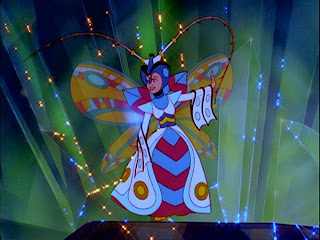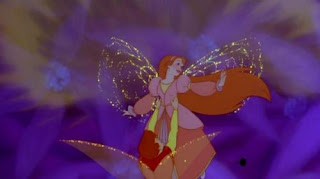Directed by: Don Bluth
"A girl no bigger than her mother's thumb feels all alone in the world knowing she is the only person her size. Her wish for a companion at last comes true when the prince of the fairies arrives at her window sill. However, the niave Thumbelina's life goes downward from there when a toad kidnaps her. While she tries to find a way home, she begins to grow up and learns about hope with the help of the friends she always wanted."
The story is set in Paris, France, yet, the only character with a French accent is the very first one, Jacquimo, the swallow. All of the other characters have fairly diverse accents; Hispanic toads, a beetle with what seems like a 'Brooklyn' accent, an English mole, the rest however have 'regular American' accents.
 |
| Only The Size Of A Thumb, She Receives The Name, Thumbelina! |
This story starts with an elder woman longing for a child. She buys, from a fairy, a flower to keep her company. As the flower blossoms, a tiny girl awakens and calls her 'mother'. As the beginning plays out Thumbelina realizes that in order for her to be happy she must marry someone of her size and she is down-trodden as she believes she is the only person her size in the world. This can play into the stereo-type that people cannot marry outside of their race, or at the very least be happy marrying outside of their race. Now, I know from personal experience that children won't catch on to this stereo-type as I didn't when I was younger. However, as the movie plays out you can see that she is very uninterested in the other pursuers (not of her race much less her species!) of her heart.
As the movie plays out, Thumbelina meets the very enchanting Fairy Prince, Cornelius. At one point we flash to the King and Queen Fairy, who are disgruntled at their son for not acting like an appropriate Prince; it seems to me that they want him to grow up too fast, he is 16 but they are saying that he behaves inappropriately for a Prince. Another thing I noticed about the fairies, who are all 'good', is that they are all white; an attribute of the fairies is their helpfulness as they are 'season' fairies. I think that children won't outwardly notice that all the fairies are white and that they are 'pure' and 'good', but I feel that they will later relate that fairies can't be colored.
After Thumbelina meets Cornelius she is kidnapped by an evil, fame hungry toad who wants Thumbelina to sing, make her rich, and to marry her eldest son. Now, I can't think of any negative stereotype to why the frogs would be Hispanic. I tried very hard to rationalize the stereotype that Mexicans are in America as a means of getting free money; well Mrs. Toad wants to use Thumbelina for her beauty, her enchanting voice, and as a means of making money. It is far-fetched theory but in a critics point of view, it can be possible. Mrs. Toad also plays into Thumbelina's walk to fame and is finding ways to make her better, for instance in the song, "On the road" she says that "perhaps we'll make her blonde!" this plays into the stereotype that blondes have more fame, that they are more beautiful, or that being blonde makes you more glamorous. Later on, somehow the toads leave Thumblelina and she is left to go home on her own.
 |
| Thumbelina As A 'Beetle' |
 |
| The Contenders for Thumbelina's Heart |
 |
| Thumbelina Becoming A Fairy |
The above examples of stereotypes that I came up with are severely unique; I had the most difficult time finding what people had to say about Thumbelina and racism or stereotypes! I talked with my mom and my fiance and together we came up with this list. The examples we found are very subtle unless you are seriously looking for it you will not find blatant racism or stereotypes in this movie. I enjoyed this movie as a kid and I have let the girls that I nanny watch it and they enjoyed it. Do I feel that this will change/distort a kind of racism or stereotype in them? Nah, I think this is a good movie to just enjoy and laugh at, you have to admit, Thumbelina is not the smartest girl!
**Summary of movie quote: http://www.imdb.com/title/tt0111419/

As I was remembering this movie, and trying to reflect back, I could not, off the top of my head recognize any stereotypes or racism other than the diverse accents and the all white fairies. I think you and you mother and fiance did a great job at looking deeper into this movie. You brought up some great points about stereotyping blondes. My two favorites points you brought up was Thumbelina not marry outside her race (little people), and Mexicans are in America as a means of getting free money; well Mrs. Toad wants to use Thumbelina for her beauty, her enchanting voice, and as a means of making money. Great job! I also think that children would not catch onto these stereotypes or racism in this movie, and I will definitely let my children watch it.
ReplyDeleteNice job. I think you brought up major issue with the film, which is primarily sexism. If you want strong female protagonists for your children, this is not the film to see. You also brought up the fairies all being white. (be careful using the word "colored" unless you are talking about walls/paper/markers/etc) You are missing your outside resources, both website addresses and including other opinions in your report. (I did find some, so I know they are out there)
DeleteFirst, what a hard movie to critique! I really enjoyed your critique and that you were able to find some kind of racism and stereotype-ish issues. I really liked what you said about the fairies being all white and that children can take away that fairies are all white all the time. To me, I thought that was really the only thing childen could take away from this movie besides all the different voices of the various creatures. Great job!
ReplyDeleteI did not see this movie before, but yes, this movie shows us about white privilege. Children of other color who watch this film may think that fairies can be white only and this can make them frustrated because as I know everyone loves fairies and want to be alike with them. But I still think that this is a good film. You did a great film critique and I enjoyed reading it.
ReplyDelete